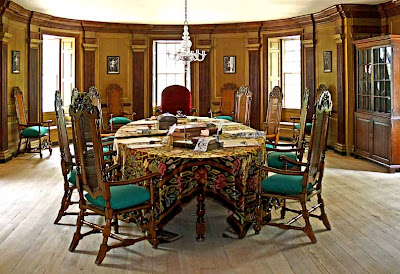You get a lot for your money at Colonial Williamsburg. From our “camp” at Anvil Campground, it was only 3 miles to the Visitor’s Center with its spacious free parking where we paid $47.00 each for 2-day passes. With temperatures hovering around 100°, we were not about to waste our energies even on a ¼ mile walk into the historic area and hopped on the waiting shuttle bus to the Governor’s Palace at the north west end of the village.
After the government moved to Richmond in 1780, this and many other buildings fell into disrepair. It was restored on the same site in 1920, using old paintings, descriptive letters and archeological data to approach authenticity. The entrance hall lined in dark cedar wood was decorated with vertical rows of crossed swords and guns, ready for the citizens to use. Another beautiful room on the second floor, with wallpaper of embossed leather, was used to entertain visitors.
From the Governor’s Palace, another shuttle bus circles the 1 mile by 1/2 mile area, stopping at strategic intervals; each stop with a concealed row of soft drink and water vending machines. Only horse drawn vehicles move through the spacious, tree-lined area.
Twice a day, there is a parade of a small drum & fife team from the Capitol to the Governor’s Palace. Visitors join the lively march down the Duke of Glouchester Street, past the market square, magazine & guard house, then up the Palace Green.
 The capital of the Virginia Colony
The capital of the Virginia Colony was located in Williamsburg.
In 1705, the first capitol building in America was built at the end of the Duke of Gloucester Street. The new site was described by the first Royal Governor, Francis Nicholson, as a place where "clear and crystal springs burst forth from the champagne soil".
A fire destroyed the building in 1747. It was rebuilt, but then after the capital was moved to Richmond in 1780, it fell into disrepair.
A fire destroyed the building in 1747. It was rebuilt, but then after the capital was moved to Richmond in 1780, it fell into disrepair.
 The guides told us of the interesting and intimate
The guides told us of the interesting and intimateevents of the Colonial Period
leading up to the Revolutionary War.
Williamsburg was the capital of Virginia through the Colonial Period. It was the center of the political and social life of Virginia for most of the 18th century. Famous members of the House of Burgesses which met in the Capital City included Patrick Henry, George Washington, George Mason, and Thomas Jefferson.
William Pasteur and Minson Galt traveled to England to study medicine before returning to Williamsburg to practice. In addition to dispensing drugs, they provided surgical, midwifery, and general medical services.
I have shown only two of the numerous small workshops with their artisans that we found throughout the village.
Every imaginable occupation was demonstrated such as: printing office, book binder, brick maker, weaver, brickyard, cabinet maker, blacksmith, baker, milliner and tailor, wigmaker, apothecary, shoemaker, gunsmith, grocer, cooper, carpenter, harness and saddle-maker and tavern keepers.

We were well satisfied with our two day visit, but three days would have been better in order to see everything.














